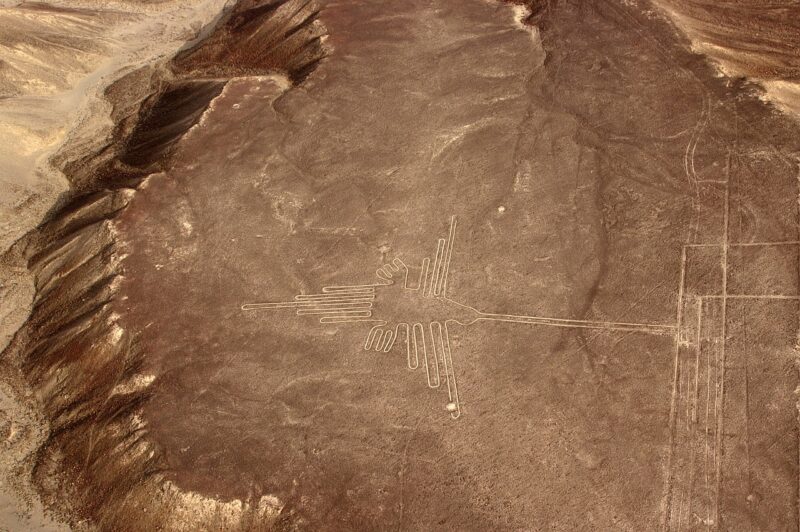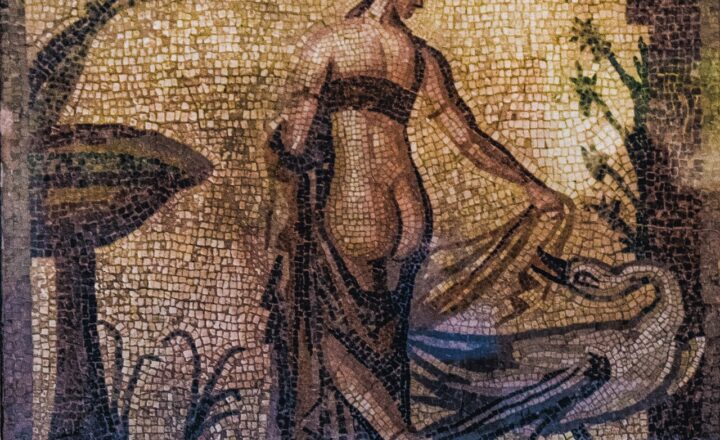
The Nazca Lines, located in the arid Nasca Desert of Peru, are one of the most enigmatic and captivating archaeological phenomena in the world. Stretching over nearly 1,000 square kilometers, these ancient geoglyphs consist of hundreds of large figures, ranging from simple lines and geometric shapes to complex depictions of animals, plants, and humanoid figures. Viewed primarily from the air, the Nazca Lines have intrigued researchers, archaeologists, and tourists alike, sparking numerous theories regarding their purpose and the techniques used in their creation.
1. Discovery of the Nazca Lines
The existence of the Nazca Lines was first made known to the wider world in the 1920s when commercial pilots began flying over the region, noticing the massive designs carved into the earth below. However, the locals had known about these geoglyphs for centuries. The Nazca culture, which thrived between 200 BCE and 600 CE, left behind these monumental artworks, which were created by removing the reddish-brown iron oxide-coated pebbles that cover the desert floor, exposing the lighter sand beneath.
As more aerial surveys were conducted, archaeologists began documenting the lines in detail. The most famous figures include a hummingbird, a monkey, a spider, and a condor, among others. The sheer scale and precision of these designs give rise to questions about the techniques used to create them and the motivations behind such grand endeavors.
2. Theories Behind Their Purpose
The purpose of the Nazca Lines remains shrouded in mystery. Various theories have been proposed over the years:
- Astronomical Calendar: Some researchers suggest that the lines served as an astronomical calendar, marking important solar and lunar events. Alignments with celestial bodies may have been significant to the Nazca people in their agricultural practices and ceremonies.
- Religious Significance: Others propose that the lines had ritualistic purposes, perhaps serving as pathways for religious ceremonies or as offerings to the gods. The sheer size of the figures would allow them to be appreciated from the heavens, inviting cosmic connections.
- Water Cults: Given the arid environment, it is theorized that the Nasca people may have created the lines to invoke deities related to water as the lines connect to underground aquifers. This theory is supported by the existence of nearby aqueducts and water management systems that reflect the society’s dependence on water resources.
- Navigation & Landmarks: Another intriguing possibility is that the lines served as navigational guides for travelers or as territorial markers, aiding nomadic groups in their journeys across the desert landscape.
Regardless of their intended purpose, the construction of the Nazca Lines demonstrates the ingenuity and social organization of the Nazca culture, allowing them to undertake such a colossal project without the modern tools we rely on today.
3. Techniques Used in Creation
Creating the Nazca Lines required meticulous planning and a solid understanding of geometry and landscape orientation. Several steps are thought to have been involved in their creation:
- Site Selection: The nascent artists would have chosen specific locations that provided ideal visibility from the air. The geographical features of the Nasca Desert—its flat and expansive terrain—were conducive for the project’s success.
- Symbol Design: Before starting to carve the lines, the Nazca people likely sketched out designs on the ground or in the sand, perhaps using rudimentary markers or by creating a scale model to guide their work.
- Line Creation:
The lines were created by moving aside the top layer of stones, a technique that required teamwork and coordination. Workers would likely have relied on simple tools, such as sticks or woven ropes, to maintain the straightness of the lines. The lines typically vary in depth from a few centimeters to nearly 30 cm, indicating the careful consideration of depth according to design requirements.
- Positional Accuracy: Utilizing landmarks and celestial bodies, the builders achieved remarkable accuracy. The largest figures can stretch over 1000 feet in length, while the smallest designs are just a few feet wide.
4. Current Preservation Efforts
The Nazca Lines were declared a UNESCO World Heritage Site in 1994, highlighting their cultural significance and the need for preservation. However, various threats, including climate change, tourism, and industrial activities such as mining, endanger these ancient geoglyphs. Preservation efforts include:
- Research and Documentation: Continuous research is undertaken to document the lines using modern technology like drones and satellite imagery. This technology gives insights into the geoglyphs’ state and offers better means to study their construction methods without additional damage.
- Regulating Tourist Access: Access to view the lines from above is strictly regulated to minimize foot and vehicle traffic across the fragile desert environment.
- Community Involvement: Local communities are encouraged to participate in preservation efforts, ensuring respect for cultural heritage while fostering tourism around these ancient lines.
The Nazca Lines remain a testament to humanity’s creativity and curiosity, reminding us of the ancient civilizations that once thrived in harmony with their environments.
5. The Nazca Lines and Modern Culture
The intrigue surrounding the Nazca Lines has permeated popular culture, inspiring artists, writers, and filmmakers. These captivating symbols have made their way into documentaries, books, and films, often associated with concepts of alien intervention and ancient astronauts—a testament to the human desire to connect with and explore the unknown.
Visitors flock to the lines, captivated by their ethereal beauty from the air, where they represent not just ancient artistry but also a deep connection to the cultural history of the Nazca people. Their preservation is crucial for future generations to appreciate this archaeological wonder and the mystery that continues to fuel our imaginations.
Conclusion
The Nazca Lines offer a glimpse into a complex and imaginative world that existed millennia ago. While the true purpose behind these giant geoglyphs may remain uncertain, their impact on our understanding of ancient cultures is undeniable. As preservation efforts continue, we can only hope to uncover more of the rich history that the Nazca Lines symbolize while maintaining and honoring this unique legacy for future generations.
By delving into the ancient mystery of the Nazca Lines, we enrich our appreciation for human creativity and the ways humankind shapes and interacts with our environment, both past and present.







